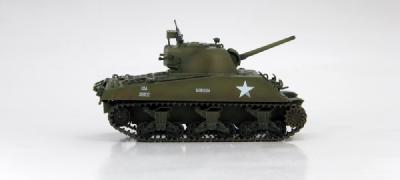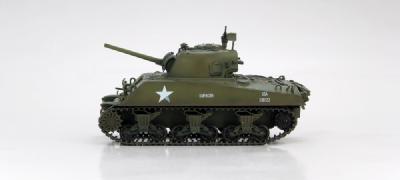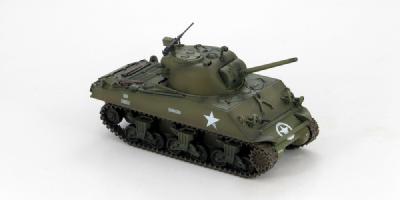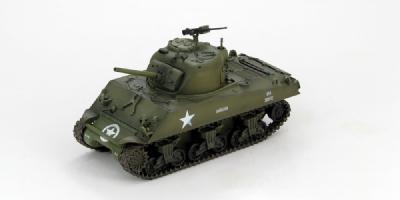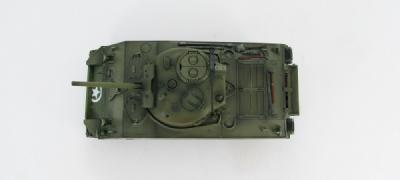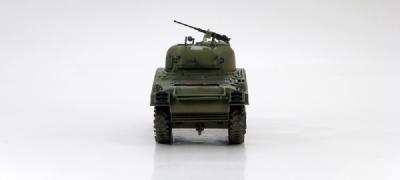Hobby Master Archive
Ground Power 1/48
Sherman
Sherman Comapny B, 41st Tank Battalion, 11th Armored Division, Bastogne, Belgium, December 30 1944, Barracuda
Hobby Master 1/48 Ground Power Series HG1004 Sherman M4A3 75MM, Company B 41st Tank Battalion, 11th Armored Division Bastogne, Belgium, Dec. 30, 1944, “Barracuda” Limited Edition 500 pieces
THESE ARE PRE-PRODUCTION PICTURES NOT THE FINAL PRODUCT
Authentic Detailing Pre-Painted by professionals Accurate paint colors Markings Tampo (pad) applied Fully Assembled Die-Cast Model True to Scale (1:48) Weathering and insignias Turret turns Main gun elevates Metal chassis, hull, turret and main gun Realistic tracks
37th Tank Battalion, 4th Armoured Division stood guard in McAuliffe Place, a small square in the center of Bastogne Belgium and printed on it was the name “Cobra King”. This was the name given to the lead tank in General Patton’s relief of the troops in Bastogne during the Battle of the Bulge. After years of standing in the rain, sun and wind the tank was in need of an overhaul. The City of Bastogne and the Belgian Army jointly decided to have the necessary work done to repair the years of neglect. In November 2006 the tank was lifted from its foundation and trucked to the Belgian Army Armory where the work would be done. It was decided that after years of existing as an imposter the tank would be painted and restored with its original name, Company and Battalion markings. It turns out this tank actually belonged to Company B, 41st Tank Battalion, 11th Armored Division and was named Barracuda. Apparently during the Battle of the Bulge on January 2 1945 two tanks became separated from the others and strayed into enemy forces. In an effort to retreat one tank was destroyed killing all its crew while Barracuda became stuck in the snow and mud and was knocked out by a German anti-tank weapon. The Tank Commander Staff Sgt. Wallace Alexander was severely wounded and died a few days later. Gunner Cpl. Cecil Peterman and Loader Pfc. Dage Herbert were wounded and captured. The driver Tech/4 Andrew Urda and Bow Gunner Pfc. Ivan Goldstein were uninjured but captured. Peterman and Herbert received a small amount of first aid and were sent to a prison camp. Goldstein and Urda weren’t as lucky and were taken to work as slave laborers. After discovering Goldstein was a Jew he and Urda narrowly escaped execution but instead were severely over worked and under fed. Eventually they ended up in the same camp as Peterman and Herbert. The men managed to hang on and were liberated but Goldstein and Urda were in such poor shape from starvation they had to spend months recovering in hospital. Barracuda with its new paint and markings was ready to return to the same place in McAuliffe Place but on a new foundation. The date for the rededication was set for May 23, 2007 with town officials as well as representatives from the Belgian Army. Some representatives from the 11th Armored Division Association were also present but sadly Ivan Goldstein, the only living crew member of Barracuda was unable to make the journey. The tank had been lifted into position early in the morning and its turret placed beside it. Later that morning the crowds gathered and watched as the turret was slowly placed on the tank completing the restoration. The crowd began to cheer and applauded followed by a few words from the Mayor and then followed by one of the Mayor’s staff explaining the history and the process of the restoration. When he was done white doves were released as the band played the Star Spangled Banner followed by the Belgian National Anthem. This was followed by a reception where Belgian citizens expressed their gratitude for the sacrifices made so they could have their freedom. The tank stands as a reminder that the free world must stand guard against tyranny so the events of WWII and all wars will never happen again.
History of the M4A3 (75mm) The prototype of the M4 was designated the T-6 and appeared in September 1941. This medium tank would go on to be one of the most important pieces of armor in WW II. Its production number of approximately 55,000 of all versions was only surpassed by the Soviet T-34 57,000 of all its versions. About 44,000 were armed with the 75mm Gun M3, with 6,465 76mm Gun M1, and 4,180 armed with the 105mm Howitzer M4. At production start up 1,000 units a month came off the assembly line with that number increasing to 2,000 per month when all 11 plants were up and running. These medium tanks played a major role in Allied victories in every TO around the world during WW II. With the advent of the M4 in 1941 came a number of improvements over the M3 series that this new tank was replacing. Instead of the fixed gun locations on the M3 a 75mm gun was relocated to the turret of the M4 and this allowed for 360-degree coverage. Also the elevation and depression of the new gun location was increased giving total combat area coverage. The M4A1 introduced a cast hull where the previous models had welded hulls. All versions of the M4 had cast turrets and sat on a ball bearing race and was recessed to protect the crew. It was realized within the first year that the early production M4s were not combat capable against their opponents. In 1943 a firm commitment to “win the war” was made and the Sherman would be the vehicle to use. This meant that the tank would have to undergo some major changes. The late production version of the 75mm first rolled out of the factories in February 1944 with an angled front hull and 63.5mm armored plate. The Sherman went through various gun and armour upgrades throughout WWII as a result of combat experience. The 75mm (M2 L/31) cannon of the early M4’s was upgraded to the higher muzzle velocity 75mm (M3 L/40). To the turret, a cupola for the commander and hatch for the loader were added. This version was also equipped with wet ammo stowage bins, which helped prevent internal fires and explosions. This occurrence was common knowledge as the Americans’ nickname for the Sherman was the ZIPPO, after the lighter (lights first time, every time), while the Germans called it the TOMMY COOKER or “Ronsons”. Late models had improved cupola, a loaders hatch, and wet storage for ammunition. The ammunition was stored in water-protected racks below the turret instead of in the sponsons. Ten boxes on the hull floor held 100 rounds and needed 37.1 gallons of water with a further gallon needed to protect the four ready rounds. The water contained ethylene glycol to prevent freezing and a corrosion inhibiter known as “Ammudamp”. The Fisher Tank Arsenal manufactured “wet” storage 76mm and 75mm armed models. In 1944 the Horizontal Volute Spring Suspension (HVSS) with a wide center guide track was fazed into production this enhanced mobility over rough terrain and enabled the Sherman to keep up with the once much faster Panthers. Units produced with HVSS suspension were called “Easy Eights”. The earlier VVSS (Vertical Volute Spring Suspension) had a much narrower track that made it difficult for the Sherman to maneuver on soft ground and mud. The VVSS had to use return rollers to prevent the track from jumping off the drive wheels or snagging. HVSS springs lie flat on the bogie assembly and are fitted in opposed pairs. Its most obvious features are dual wheels with a shock absorber above the cylindrical spring units. Over 44,000 were armed with the M3 75mm Gun. Production figures for “wet” storage 75mm armed models totals 3,071 tanks and ended in March 1945. With continual upgrades the Sherman became a very nimble weapon that was reliable and easy to maintain. Never as technically advanced as the German Tigers but the sheer numbers of M4s and T-34s that could be thrown at the Germans would overwhelm them and in the end would assure victory.
Specs for the M4 Designation: M4 General Sherman Also Known As: M4 Sherman Classification: Medium Tank Service Date: 1942 Weight: 29.62 tons Length: 19 feet, 4 inches Height: 9 feet Armor: 0.99 - 1.97 inches Maximum Speed: 24 mph Maximum Range: 99 miles Crew: 5 Armament: 75mm main gun; 3 x .30 caliber machine guns (1 x Anti-Air Defense .50 caliber (12.7mm) machine gun; 1 x .30 caliber (7.62mm) Co-axial machine gun; 1 x .30 caliber (7.62mm) bow machine gun. Ammunition: 97 rounds (75mm gun); 4,750 rounds (Machine guns) Models: M4 (Wright engine/welded hull); M4A1 (Wright engine/cast hull); M4A2 (GM Diesel engine); M4A3 (Ford GAA engine); M4A4 (Chrysler/long hull); M4A6 (Part-cast hull)
| Added to archive | 2015-11-19 |
| Last modified | 2015-11-19 |
| Leaflet | 2008-05-01 May 2008 |
